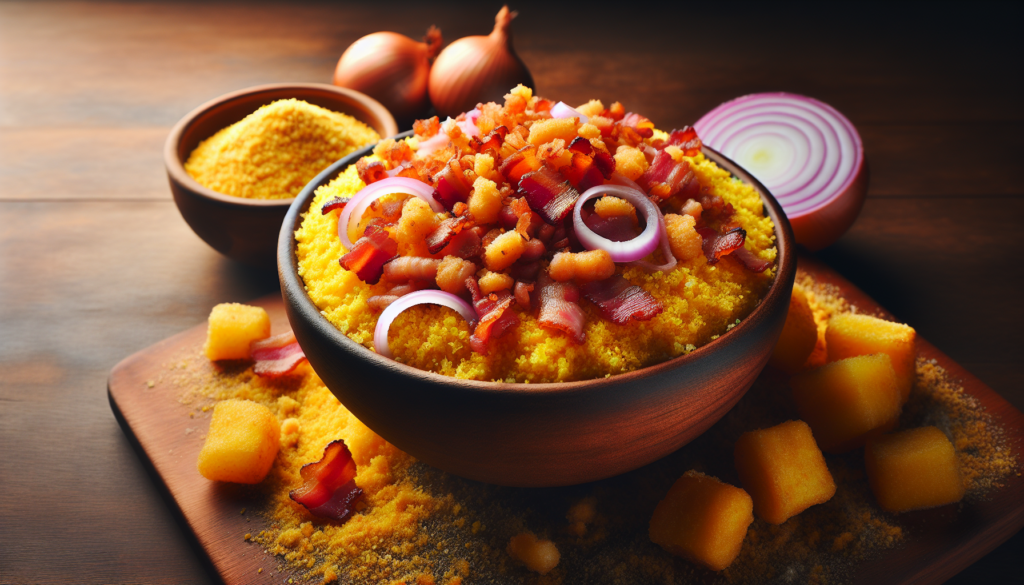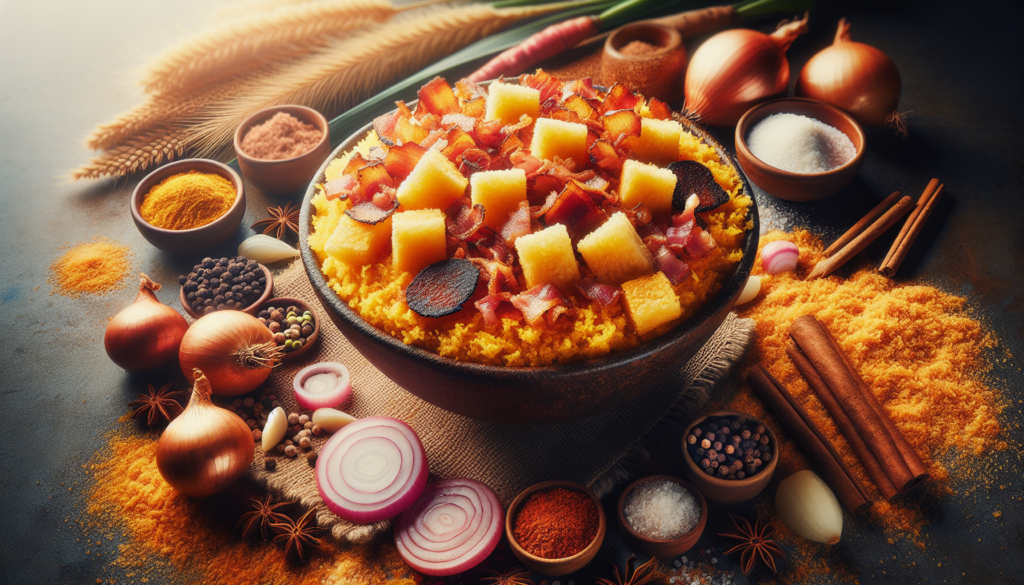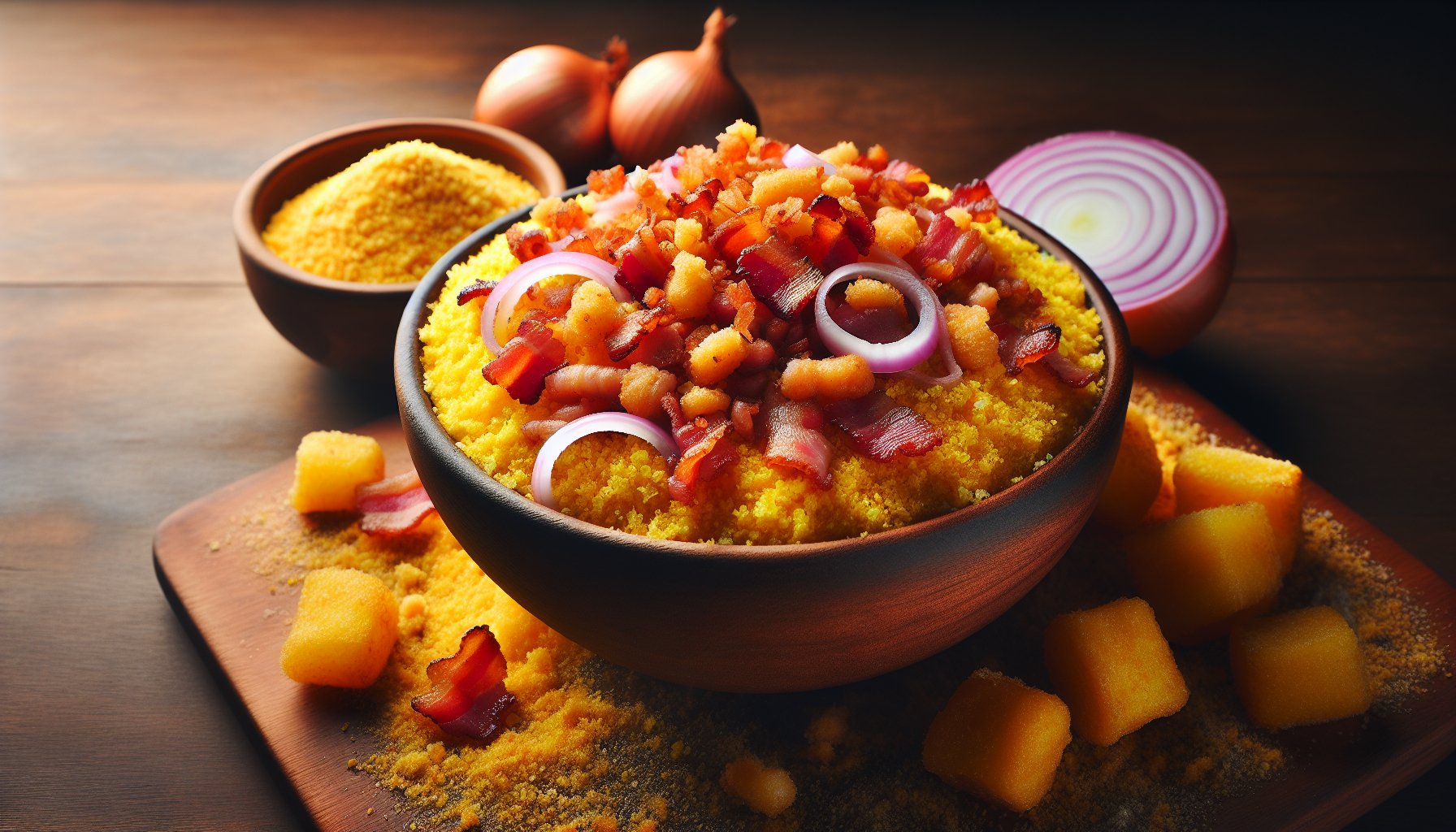Imagine yourself savoring a taste explosion of flavors that can only come from the vibrant cuisine of Brazil. In this article, we will share with you a delightful recipe for Farofa, a traditional Brazilian dish packed with authentic ingredients that will transport your taste buds to the sunny beaches of Rio de Janeiro. Prepare yourself for a culinary journey like no other, as we guide you through the steps to create this mouthwatering delight that is sure to impress both your palate and your dinner guests. Get ready to experience the true essence of Brazilian cooking as we unlock the secrets of a truly delicious Farofa.
Ingredients
Manioc flour
Manioc flour, also known as cassava flour, is a staple ingredient in Brazilian cuisine and plays a central role in making farofa. Made from the dried and ground root of the manioc plant, this flour has a fine texture and a slightly nutty flavor. It is the main ingredient that gives farofa its unique taste and texture.
Bacon
Bacon adds a smoky and savory flavor to the farofa. It is typically diced or chopped into small pieces and cooked until crispy. The rendered bacon fat adds richness to the dish, complementing the other ingredients.
Onion
Onion provides a sweet and aromatic flavor to the farofa. It is usually diced or finely chopped before being sautéed. As it cooks, the onion becomes tender and caramelizes, adding a depth of flavor to the dish.
Garlic
Garlic adds a pungent and aromatic taste to the farofa. It is minced or finely chopped before being sautéed alongside the onion. The combination of garlic and onion creates a flavorful base for the dish.
Butter
Butter is used to sauté the onion and garlic, adding richness and a silky texture to the farofa. It helps bind the ingredients together and enhances the overall flavor of the dish.
Salt
Salt is an essential seasoning in any dish, including farofa. It enhances the flavors of the other ingredients and brings out their natural taste. To ensure proper seasoning, it is important to taste and adjust the salt accordingly.
Black pepper
Black pepper adds a subtle spicy and earthy flavor to the farofa. It complements the other seasonings and brings balance to the dish. Adding black pepper enhances the overall taste and complexity of flavors.
Parsley
Parsley is used as a garnish in farofa, providing a fresh and vibrant element to the dish. Its bright green color adds visual appeal, and its mild and slightly peppery flavor complements the other ingredients. Chopped parsley is sprinkled on top of the finished dish, adding a pop of freshness.
Optional ingredients (such as eggs, olives, or diced vegetables)
Farofa is a versatile dish that can be customized according to personal preferences. Optional ingredients such as eggs, olives, or diced vegetables can be added to enhance the flavor and texture of the dish. These additional ingredients can add variety and create exciting combinations.
Preparation
Step 1: Prepare the ingredients
Gather all the necessary ingredients for the farofa recipe. Measure the manioc flour, dice the bacon, finely chop the onion and garlic, and gather the butter, salt, black pepper, and parsley. Having all the ingredients prepared and ready will make the cooking process smoother and more efficient.
Step 2: Cook the bacon
In a large skillet or frying pan, cook the diced bacon over medium heat until it becomes crispy and golden brown. Make sure to stir occasionally to ensure that the bacon cooks evenly. The rendered fat from the bacon adds a rich flavor to the farofa and helps to sauté the other ingredients.
Step 3: Sauté the onion and garlic
Once the bacon is cooked, remove it from the skillet, leaving the rendered fat behind. Add the diced onion and minced garlic to the skillet and sauté them in the bacon fat until they become translucent and fragrant. The combination of bacon fat, onion, and garlic creates a delicious flavor base for the farofa.
Step 4: Add the butter and manioc flour
Add the butter to the skillet and allow it to melt into the onion and garlic mixture. Once melted, gradually add the manioc flour, stirring continuously to coat it evenly with the butter and other ingredients. The manioc flour will absorb the flavors and moisture from the other ingredients, creating a delicious and aromatic base for the farofa.
Step 5: Season with salt and black pepper
Season the farofa with salt and black pepper, adjusting the amount according to your taste preferences. Stir well to ensure that the seasonings are distributed evenly throughout the dish. Taste the farofa and add more salt or black pepper if needed.
Step 6: Add optional ingredients
At this stage, you can add any optional ingredients you desire to customize your farofa. Consider adding diced vegetables like carrots, corn, or peas, which add color, texture, and additional flavors to the dish. You can also add sliced olives or cooked eggs for extra taste and variety. Stir well to incorporate the optional ingredients into the farofa mixture.
Step 7: Garnish with parsley
Once the farofa is cooked and all the ingredients are well combined, remove it from the heat. Sprinkle freshly chopped parsley over the top of the dish as a garnish. The parsley adds a burst of freshness and complements the flavors of the farofa.
Step 8: Serve and enjoy
Farofa is traditionally served as a side dish or accompaniment to a variety of Brazilian meals. Spoon the farofa onto a plate or serving dish and serve it alongside grilled meats, stews, or feijoada, a popular Brazilian black bean dish. The farofa’s unique texture and flavors will add a delightful element to any meal.

Variations
Vegetarian Farofa
To make a vegetarian version of farofa, simply omit the bacon and use vegetable broth or oil for sautéing the onion and garlic. The remaining ingredients and steps can be followed as usual. The absence of bacon is compensated by the flavors of the other ingredients, creating a delicious vegetarian alternative.
Egg Farofa
For an egg farofa, cook the bacon as usual and set it aside. In the same skillet, scramble some eggs until cooked to your liking. Remove the eggs from the skillet and set them aside. Follow the remaining steps of the farofa recipe, adding the cooked bacon and scrambled eggs at the end when incorporating the optional ingredients. The eggs add a protein-rich component to the farofa.
Black Olive Farofa
For a black olive farofa, follow the basic farofa recipe and add sliced black olives as one of the optional ingredients. The briny and salty taste of the olives pairs well with the other flavors and provides an extra burst of flavor and texture to the dish.
Vegetable Farofa (e.g., carrot, corn, peas)
To create a vegetable-packed farofa, dice or chop vegetables of your choice, such as carrots, corn, and peas. Sauté the vegetables along with the onion and garlic in step 3. Continue with the remaining steps of the farofa recipe as usual. The variety of vegetables adds color, texture, and nutritional value to the farofa.
Tips
Choose the right type of manioc flour
When selecting manioc flour for your farofa, opt for the finer texture variety, often labeled as “finely ground” or “fine.” This type of flour easily absorbs the flavors of the other ingredients and helps create the desired texture for the farofa.
Cook the bacon until crispy
To achieve a crispy texture, cook the bacon until it turns golden brown and develops a crispy texture. The crispy bacon adds a delightful crunch to the farofa and enhances its overall taste.
Dice the onion and garlic finely
To ensure even cooking and distribution of flavors, dice the onion and garlic into small and uniform pieces. Finely chopping these aromatics allows them to release their flavors more effectively and ensures that they blend seamlessly with the other ingredients.
Sauté the onion and garlic until golden
Take the time to sauté the onion and garlic until they become golden brown. This helps to develop their flavors and brings out their natural sweetness, which enhances the taste of the farofa.
Adjust the salt and black pepper to taste
Taste the farofa before serving and adjust the salt and black pepper according to your preferences. Remember that the farofa should be well-seasoned but not overly salty. Add small increments of salt and pepper at a time, tasting as you go, to ensure the perfect balance of flavors.
Experiment with different optional ingredients
Feel free to experiment with different optional ingredients to create unique versions of farofa. From diced vegetables to various herbs and spices, the options are endless. Don’t be afraid to get creative and personalize your farofa according to your taste.
Garnish with fresh parsley for added flavor
Fresh parsley not only adds visual appeal but also contributes to the overall flavor of the farofa. It provides a subtle herbaceous note and complements the other ingredients in the dish. Don’t skip the garnish of fresh parsley as it adds a finishing touch to the farofa.

History of Farofa
Origin and cultural significance
Farofa is a traditional Brazilian dish with an origin rooted in indigenous cuisine. The indigenous tribes of Brazil often used manioc flour as a staple food due to its abundance and long shelf life. Over time, Portuguese colonizers introduced bacon, onion, and garlic, which transformed the simple manioc flour into the flavorful farofa we know today.
Farofa holds significant cultural value in Brazilian cuisine. It is considered a symbol of sharing and communal meals, often served during special occasions and celebrations. It is a versatile dish that can be enjoyed by people of all ages and backgrounds, reflecting the diversity and richness of Brazilian food culture.
Evolution of the recipe over time
Throughout history, farofa has evolved and adapted to reflect the changing culinary influences in Brazil. Different regions of the country have their own variations of farofa, incorporating local ingredients and flavors. The addition of optional ingredients, such as eggs, olives, or diced vegetables, further demonstrates the versatility and adaptability of the dish.
The recipe for farofa has been passed down through generations, with families adding their own twists and adaptations. It has become a beloved tradition, with each cook incorporating their personal touch, whether it be in the choice of ingredients, cooking techniques, or the presentation of the dish.
Traditional uses and occasions
Farofa is commonly served as a side dish in Brazilian cuisine, accompanying a variety of meals. It adds a unique texture and flavor profile to dishes such as feijoada, a traditional Brazilian black bean stew, barbecued meats, and rice dishes. Farofa is often enjoyed during festive occasions, such as holidays, parties, and family gatherings, bringing a sense of comfort and celebration to the table.
Where to Find Manioc Flour
Specialty Brazilian grocery stores
Specialty Brazilian grocery stores are an excellent place to find manioc flour. These stores often carry a wide variety of Brazilian ingredients and products, including different types of manioc flour. The knowledgeable staff can guide you in selecting the right flour for your farofa recipe and provide information about its origin and uses.
Online retailers
Many online retailers offer manioc flour for purchase, providing convenience and accessibility for those looking to make farofa at home. With just a few clicks, you can have manioc flour delivered to your doorstep, allowing you to embark on your farofa-making adventure.
Latin American markets
Latin American markets, which cater to a diverse range of culinary needs, are likely to carry manioc flour. These markets often stock a variety of ingredients from different Latin American countries, including Brazil. Explore your local Latin American market and discover a treasure trove of authentic ingredients, including manioc flour.
Local international food stores
Some local international food stores carry a selection of Brazilian ingredients, including manioc flour. These stores cater to the diverse tastes and preferences of their customers, offering a range of global ingredients and products. Visit your local international food store and inquire about their selection of Brazilian ingredients.
Health Benefits of Farofa
Good source of fiber
Farofa made with manioc flour is a good source of dietary fiber. Fiber plays a crucial role in digestion and helps maintain a healthy digestive system. It adds bulk to the diet, promoting regular bowel movements and preventing constipation.
Provides essential minerals
Manioc flour used in farofa is rich in essential minerals such as potassium, magnesium, and iron. Potassium is important for maintaining healthy blood pressure, while magnesium helps support optimal nerve and muscle function. Iron is essential for the production of hemoglobin, which carries oxygen throughout the body.
Adds texture to meals
Farofa’s unique texture adds a delightful element to meals. It provides a contrast to softer dishes, adding a satisfying crunch and depth of flavor. The combination of the smooth manioc flour, crispy bacon, and sautéed onion and garlic creates a textural experience that enhances the overall enjoyment of the meal.
Can be a flavorful alternative for gluten-free diets
Manioc flour used in farofa is naturally gluten-free, making it suitable for individuals with gluten intolerance or celiac disease. Farofa offers a delicious and versatile alternative to gluten-containing grains, allowing those with dietary restrictions to enjoy a flavorful and satisfying dish.
Conclusion
Farofa is a versatile and delicious Brazilian dish that can elevate any meal. The combination of manioc flour, bacon, onion, garlic, butter, and seasonings creates a flavorful and texturally satisfying side dish. With the option to customize with various optional ingredients, farofa offers endless possibilities for culinary exploration.
Whether you’re enjoying traditional feijoada, barbecued meats, or simply looking to add a touch of Brazil to your meals, farofa can be the perfect accompaniment. Its rich history, cultural significance, and adaptability reflect the vibrant and diverse food culture of Brazil.
So, gather your ingredients, follow the simple steps, and embark on a culinary adventure with farofa. As you savor each spoonful, you’ll be transported to the lively streets and vibrant flavors of Brazil. Enjoy the versatility and explore different variations of farofa to make it your own.
